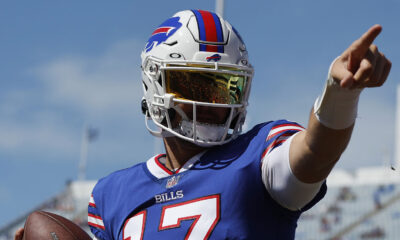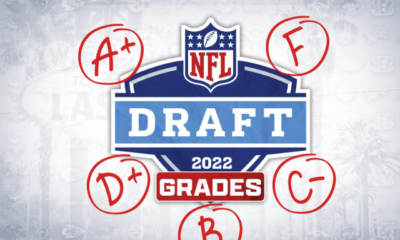
If only it were this easy…
Professional football has become obsessed with numbers.
Not MLB-obsessed, of course – the staggering amount of baseball rotogeek statistics that circulate before, during and after every baseball season is enough to drive most casual fans from ever trying to analyze their teams anywhere but in offline conversations – but in the NFL, they’re used as a measure of success or failure at any position at any time. Bragging rights are often established through numbers, as are Hall of Fame qualifiers, free agent eye-catchers, and fan estimation.
Most of them are simple. Running backs are weighed by rushing yards, yards per carry, longevity, and touchdowns. Similarly, wide receivers are measured by number of catches, yards per catch, yards per game, career totals, and (of course) touchdowns. Every position has these measurables, and every position is tracked and analyzed by them.
And then there are quarterbacks.
Often referred to as “the most important position on the field” (which it undoubtedly is), quarterbacks are measured, depending on who your source is, by a complicated mix of yards, attempts, yards per attempt, completions, yards per completion, touchdowns, winning percentage, losing percentage, interceptions, fumbles, and general rallying source for their team. I’m referring loosely to ESPN’s convoluted “QBR” system, which, in a presumed effort to redefine the sports world (as ESPN often does), includes such ridiculous factors as a “clutch index”, which comes across as completely arbitrary and subjective (sorry, Trent Dilfer, I know this is your brainchild, but the arrogance of attempting to rewrite a system solely to boost your network’s popularity just tells me you’re just not worth the time to try to quantify it). Instead, we’ll go with the time-honored quarterback rating system, which measures a very real completion percentage, yards per attempt, touchdowns, and interceptions as the means to define overall quarterback play. The formula has been employed for decades to establish a quarterback’s general worth on the field, and refreshingly leaves out such useless metrics as a winning percentage, because (and as fans should be able to attest), no quarterback is able to control what happens in roughly 70 percent of a game, because they’re just not able to get on the field to influence such things as defense and special teams (with all due respect to Danny White and Randall Cunningham, who occasionally punted for their respective squads).
The NFL has seen a marked rise in quarterback ratings since the AFL/NFL merger in 1966, when a quarterback rating of 80.0 or above was considered superlative. This link provides a nice list of quarterback rating leaders since way back, although the passing systems employed were vastly different in, say, the 1930’s than they are now, which somewhat skews the numbers. For our purposes, we’ll look at 1984 to 2014, which showcases a low rating among the leaders of 92.6 (Tommy Kramer, 1986) and a high of 119.2 (Nick Foles in 2013; Aaron Rodgers is still working on this season). Pretty impressive and consistent numbers throughout this 30-year span, as a 92.6 rating is still considered to be pretty good, even by today’s elevated standards.
But these are just the leaders. What about the rest of the league?
This link shows the top passers by rating from 1984. Excluding such luminaries as Mike Kerrigan, Dean May and the oft-injured Jim McMahon, the top five starters posted ratings between 89.7 and 108.9. Note that there were only two full-time starters that posted ratings over 100; Hall of Famers Joe Montana and Dan Marino. The rest of league checks in at a forgettable clip of roughly 70.0 to 88.0, with a low among starters at 67.3 by the eminently forgettable Paul McDonald, who was one of the primary reasons the Browns drafted Bernie Kosar the following year.
Now, check out the same list from 2013. Again bypassing non-starters, there are nine quarterbacks that posted a rating of 89.6 or better, with six of those over 100.0. The lowest rating of all 32 starters was supplied by rookie Geno Smith, who may have actually regressed since posting his ghastly 66.5.
Records during the preceding three decades reveal a gradual overall increase in quarterback play leaguewide, and the analysts and league “experts” have any number of theories to account for this, most notably the advent of pro-style offenses being employed in the NCAA, with a marked reduction in option-style / wishbone systems, which often require quarterbacks to be more runners than passers. Quarterbacks are generally larger, more superior athletes than they used to be, as the current prototype NFL passer is roughly 6’5″, 220 lbs. Mobility is more valued than ever before, as the longevity of a quarterback can no longer be dictated by the effectiveness of an offensive line. More and more, the quarterback position is seeing an excess of players like Cam Newton and Blake Bortles, rather than exceptions like Drew Brees.
As fans, we’ve come to expect a certain level of excellence from our quarterbacks. We’re often drawn in by the numbers they post rather than the overall results of their play (I’m looking at you, Brian Hoyer and Joe Flacco bashers), and we hold grudges against them if they’re not among the “elite” passers every year, as this would seem to indicate that they’re not capable of winning unless they do it themselves. Far be it from me to defend Washington quarterback Robert Griffin III, but in last weeks’ cacophony of his post-loss statements, he identified that it takes eleven ballplayers to make an offense work (the fact that he was universally trashed for it is another matter, as this seemingly showed a lack of accountability for his poor play, but we’ll save that for another column).
He’s right.
Given proper protection and capable receivers, almost any quarterback can succeed in the NFL (for the best indicator of this, google Washington’s Mark Rypien and look at his year-by-year numbers, particularly 1991, when his line sent three players to the Pro Bowl). It’s called a team for a reason, and even in this Roger Goodell-influenced, gaudy-number-accruing era, other players than the quarterback have to be effective to make the team effective. The fact that we’ve leaned more and more heavily on these metrics says more about us than it does our quarterbacks, as immediate gratification pretty well defines the modern fans’ needs and wants. It’s never exclusively about the numbers.
So go easy on your quarterbacks, folks. Their ratings may, by definition, suck sometimes.
But that won’t necessarily mean their team will.






































Facebook
Twitter
RSS